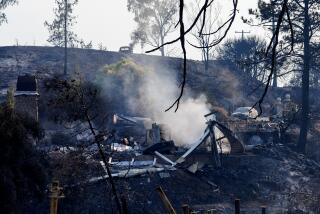This Way to the Wild Blue Yonder
Since the infancy of manned flight, Orange County has been a proving ground for those magnificent men and women in their flying machines. That proud heritage is being celebrated in “Take to the Sky: The History of Aviation in Orange County,” an exhibit of photographs, signs and other memorabilia at the Old Courthouse Museum in Santa Ana. “Passengers around John Wayne Airport are probably not aware of the hallowed ground they are standing on,” says Vi Smith, guest curator and author of “From Jennies to Jets, the Aviation History of Orange County.”
When adventurer Glenn L. Martin built a flying “contraption” from scratch in 1908, he wrecked the monoplane on its maiden flight. But a year later, Martin piloted a second plane for 12 seconds at a height of 8 feet from a dirt runway at a Santa Ana farm. He founded the Glenn L. Martin Co. in Orange County in 1910 and moved it to Los Angeles in 1912, then back East. The company produced the Martin Bomber, which gained fame in World War I after Gen. Billy Mitchell sank a German warship off the coast of Virginia while piloting a Martin. The company made the U.S. a dominant air power during the 1920s and 1930s and trained some of the biggest names in aviation manufacturing, including William Boeing, Lawrence Bell, James S. McDonnell and Donald Douglas. The company later became defense contractor Martin Marietta before becoming Lockheed Martin in 1995.
For the record:
12:00 a.m. April 6, 2003 For The Record
Los Angeles Times Tuesday March 11, 2003 Home Edition Main News Part A Page 2 National Desk 1 inches; 59 words Type of Material: Correction
Warship bombing -- In a Los Angeles Times Magazine article on the origins of aviation in Orange County (“This Way to the Wild Blue Yonder,” Metropolis, March 2), it was incorrectly stated that Gen. Billy Mitchell sank a German warship in World War I. Mitchell sank the warship in a test bombing in 1921, after the war had ended.
For The Record
Los Angeles Times Sunday April 06, 2003 Home Edition Los Angeles Times Magazine Part I Page 4 Lat Magazine Desk 1 inches; 54 words Type of Material: Correction
In the article on the origins of aviation in Orange County (“This Way to the Wild Blue Yonder,” Metropolis, March 2), it was incorrectly stated that Gen. Billy Mitchell sank a German warship in World War I. In fact, Mitchell sank the warship in a test bombing in 1921, after the war had ended.
Daredevil “wingwalker” Eddie Martin (no relation) opened a Santa Ana landing strip in 1923. Martin, an auto mechanic licensed by Orville Wright, gave rides in his JN4D trainer aircraft for $2.50 on weekends from property a mile north of what’s now John Wayne Airport. Charles Lindbergh landed at Eddie Martin Field in 1928 on his way to see Sterling Price’s massive Albatross (wingspan: 90 feet) in Westminster, and Amelia Earhart made a forced landing at Martin because of mechanical problems in 1934, Smith says. “She was upset. She didn’t want any publicity about it. It leaked into the papers.” The next year, Earhart watched Howard Hughes set a speed record of 352.46 mph with his all-metal, low-wing H-1 monoplane on a course extending from Martin Field to the nearby Holly sugar beet factory. “On the seventh pass, he belly-flopped,” Smith says.
In 1942, the Navy built its Lighter Than Air facility in Tustin, with its two massive 1,000-foot-long, 170-foot-high hangars, to house blimps used for observation platforms along the coast during WWII. The Tustin base later became a helicopter center for the Marine Corps, but like many bases in Orange County, it eventually closed. Today the county’s aviation/aerospace industry, which employed tens of thousands of people in Orange County in the 1970s, is geared more toward high-tech, Smith says, and the area’s airports today number two, down from 28 before WWII.
As to why Orange County became a hub of aviation, Smith says that excellent weather, wide-open spaces and proximity to Los Angeles and San Diego made it a good landing spot. “You could always find a place to land,” says Smith, 78, a north Tustin resident. “Now the only place to land is the freeway.”
*
“Take to the Sky: The History of Aviation in Orange County” is on display through Dec. 31 at the Old Courthouse Museum, 211 W. Santa Ana Blvd., Santa Ana; (714) 834-3703.
More to Read
Sign up for The Wild
We’ll help you find the best places to hike, bike and run, as well as the perfect silent spots for meditation and yoga.
You may occasionally receive promotional content from the Los Angeles Times.






